Relationship of Flow Rate and Pressure for Positive Displacement and Centrifugal Pumps
The relationship of flow rate and pressure differs for centrifugal and
positive displacement pumps. This article explains this relationship using
Wanner™ Hydra-Cell® Pro sealless positive displacement pumps and their
Stan-Cor centrifugal pumps as examples.
Pumps Create Flow, Not Pressure
A pressure gauge reflects measurement of the resistance to the flow rate
and the performance of a centrifugal pump reacts differently to that resistance
than a positive displacement pump does.
The flow rate for a given size
centrifugal pump at a specific shaft speed is intertwined with the discharge
pressure; higher pressures are only obtained at lower flow rates. The
reason for this is due to the limitations of the velocity generated and
inefficiencies inherent with the spacing between the impeller and
volute.
Positive displacement pumps displace a fixed volume of fluid per pump
shaft rotation; flow rate is negligibly affected by higher pressures due to
check valves within the pump head to control the direction of flow. The slight
decrease in flow rate at higher pressures equates to about 1% for each 100%
increase of pressure.
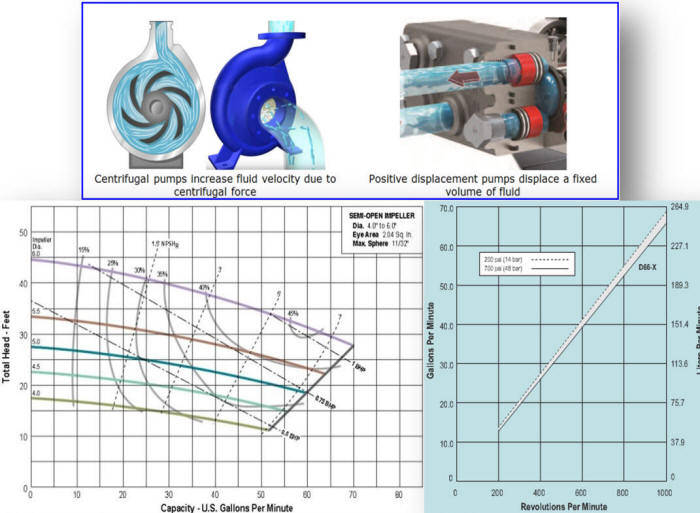
Comparing Performance Curves
Referring to the
semi-open impeller performance curve, at about 34 total head feet (almost 15
PSI) a 6” diameter impeller would result in a flow rate of approximately 50 GPM.
The addition of piping and related components would result in a decrease in
flow rate because additional pressure is required to overcome those losses.
In this example, when the pressure increases by about 14% to 40 total head feet,
the flow rate is reduced by 40% (to about 30 GPM).
Referring to the positive
displacement pump curve, when operated at approximately 740 RPM the flow rate
will be approximately 50 GPM at 200 PSI and about 48.6 GPM at 700 PSI; a
decrease in flow of about 3% based upon a 350% increase in pressure.
Therefore,
centrifugal pumps have a flow rate proportional to the pressure they are pumping
against whereas positive displacement pumps have a flow rate proportional to the
pumps shaft speed.
Troubleshooting Lack of Pressure
Since gauge pressure is
a function of flow rate, the causes for lack of pressure are really issues
regarding flow rate. While there are many factors to consider including
improper electrical wiring and aerated/turbulent fluids, below is a summary for
common system issues resulting in reduced flowrate for both centrifugal and
positive displacement pumps:
Inlet Related
Inadequate Net Positive
Suction Head Available (NPSHa) which could involve clogged filtration
Pump
Related
Component wear or material clogging within the pump
Outlet
Related
A worn bypass valve might contribute to loss of flow/pressure
Troubleshooting
Hydra-Cell Pumps
Hydra Cell Pro
pumps are a type of sealless, positive
displacement pump, using a hydraulically balanced diaphragm as the displacement
mechanism. As such, Hydra-Cell pumps do not have a dynamic seal interface
which plunger and piston style positive displacement pumps have and thus are
more reliable, especially for difficult to pump fluids. The simplified
design of Hydra-Cell pumps also simplifies troubleshooting.
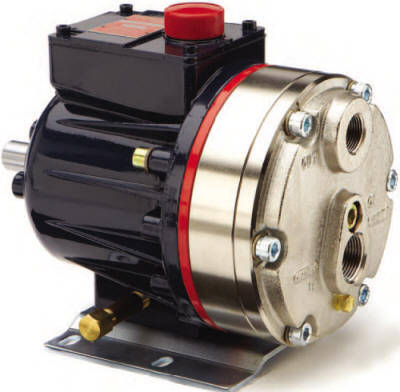 Troubleshooting
New Hydra Cell Pro
Pumps
Troubleshooting
New Hydra Cell Pro
Pumps
If you are not receiving the pressure/flow desired, the
likelihood that you have a system issue is very high because Hydra Cell
Pro
pumps
are tested at full flow rate and pressure prior to shipment. Unlike other
manufacturers, which test only a percentage of their products, 100% of
Hydra Cell Pro
pumps are tested prior to shipment so you can be confident it was
working when it was shipped.
In my experience, most flow rate issues are related
to the inlet side of a system. You need to ensure that there is sufficient
fluid available to support the desired flow rate. Even though Hydra
Cell Pro pumps
have some suction lift capabilities and will self-prime, insufficient NPSHa will
starve the pump of adequate fluid resulting in cavitation. Simply put,
trying to displace more fluid than available results in a vacuum condition
allowing the liquid to change to its vapor phase; this violent phase change
results in rough running (flow/pressure) and operating this way for prolonged
periods can damage the check valves.
A way to check if this is an issue is to
slow the pump speed down to see if the pumping action becomes smoother and
quieter. If it does, it is confirmation of inadequate NPSHa.
Pumps which
start-up as expected but begin to operate roughly after a period of time might
be symptomatic of clogged filtration, aeration of fluid due to a high percentage
of recirculation or a change in the head pressure available as the feed tank
volume decreases (lack of NPSHa).
Newer pump systems which initially worked well,
but then sat idle for months will sometimes have “stuck” internal check valves
due to residual fluid remaining within the pump which dried out or otherwise
left a sticky residue. A pressurized inlet, such as city water pressure,
can free-up sticky valves.
On the discharge side of a new pump system, make sure
that your pressure-regulating valve is set properly. Generally you should
set the pressure regulating valve to the maximum allowable pressure you wish to
operate at after the pump has primed itself and if you are not receiving the
desired pressure, is there fluid being bypassed? Since pressure is a
function of flow rate, there needs to be adequate restriction, so bypasses, leaks
and oversized/worn spray nozzles are factors to consider.
Troubleshooting
Existing Hydra-Cell Pumps
Pumps which have a history of performing
satisfactorily are often easier to troubleshoot because rough running is
typically related to worn check valves. The check valves within the pump
head can cycle up to 29 times per second when operated at 1750 RPM, so
eventually the interface of the valve and seat wears. Worn check valves
reduce sealing efficiency and the flow rate decreases as a result. This is
especially noticeable when pumping at elevated pressures. Check valves are
easy to replace and are offered in many materials to maximize both chemical
resistance and abrasive wear.
Hydra Cell Pro
pump elastomers (o-rings and diaphragms)
are not typically wear items; whereas you can predict check valve wear with some
success, o-rings and diaphragms do not exhibit that type of wear. Chemical
and temperature incompatibility can degrade these elastomers but when that is
not an issue, o-rings and diaphragms last years. Many customers elect to
replace the elastomers when they replace their check valves because it does not
add much to the overhaul kit cost and the pump head is already opened to replace
the check valves, so it is a prudent, proactive approach to pump maintenance.
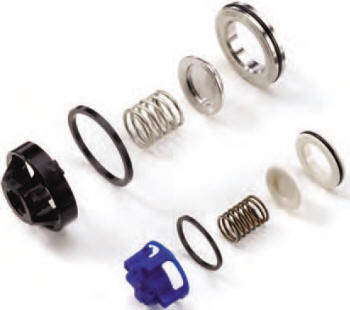
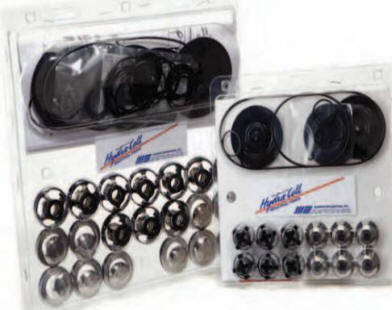
Troubleshooting
Stan-Cor Centrifugal PNPSHa, excessive aeration of the pumped fluid and
clogs restricting flow in piping or the pump head affect the flow rate for
centrifugal pumps just as they do positive displacement pumps. In addition
to the aforementioned troubleshooting suggestions, centrifugal pumps have
additional factors to consider.
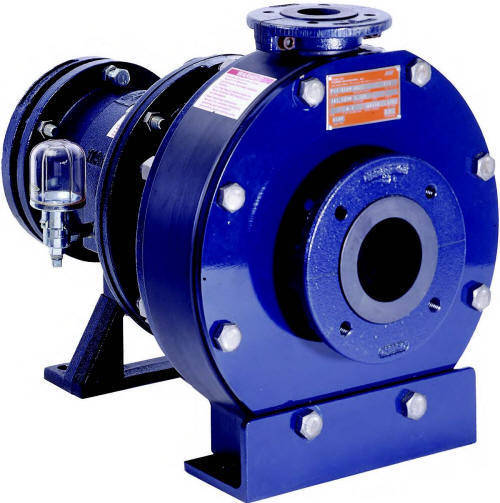
Stan-Cor centrifugal pumps, like many centrifugal
pumps, are not self-priming. They require filling the pump and inlet line
with fluid prior to start-up. After start-up the resulting vacuum created
will provide some suction though the inlet side of the system. the system.
Even though check
valves are not used to control flow direction, the clearance between the
impeller and volute is critical to generate the required discharge velocity.
Clogged or worn volutes and impellers may significantly reduce the flow rate.
Selecting
the Right Pump for Your Application
Generally speaking, centrifugal pumps are
best suited for applications involving water-like viscosities and transferring
higher flow rates at lower pressures whereas positive displacement pumps are
required for higher pressures and often used for difficult to pump fluids.
The best pump for your application depends upon many factors, so even if
different style pumps can provide the desired flow rate, some designs are better
suited than others when considering reliability and cost of ownership. The
next time you have a pump application reach out to us using one of our special
web based inquiry forms, send an email or call our office; we will put our
decades of experience to work for you!
Visit us at
https://innovativepumps.com/
and let us know how we can assist you with your pumping application!






